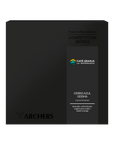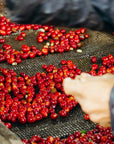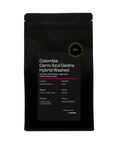One of the earliest introductions of the Geisha variety from Panama to Colombian soil has been attributed to Rigoberto Herrera, who commenced CGLE’s Geisha growing chapter around 15 years back, when he decided to plant this highly sought-after, luxury variety in their farms, after his Panama project, La Carleida, won at the Best of Panama.
Geisha is a rare coffee variety with an extremely delicate root system that requires the perfect alignment of climatic, agronomic, and temporal factors in order to thrive and bear cherries with the level of complexity and flavor clarity coffee champions and discerning specialty coffee connoisseurs appreciate best.
While its exceptional cup quality potential has pre-eminently been recognized in association with Panama since debuting in the global luxury coffee scene in 2004, by way of the Best of Panama Auction, Geisha has also triumphantly been acclimatized to idyllic coffee-growing terrains in Colombia by the elite and progressive among specialty coffee producers, such as Café Granja La Esperanza.
To direct Cerro Azul Geisha’s cup profile towards clear and verdant sweetness balanced by a textural juiciness with sparks of citrus, interlaced with tiered florality, a Hybrid Washed post-harvest processing method was used.
Having collected only properly ripe cherries from the pickers, the cherries were manually segregated at least three more times. Sorters used visual and tactile cues to re-check the level of ripeness, and then proceeded to separate what they determined to be the good ones from the rest. Only these good, ripe cherries went into flotation, whereby floaters were removed and what remained went further into processing for two stages of fermentation and the requisite drying phase.
The whole cherries were placed in tanks which were closed but not sealed, allowing air to flow naturally, for the first stage of fermentation for 19 to 22 hours prior to de-pulping. Once de-pulped, with the adequate equipment, remarkably without the use of water, the cherries were again fermented in parchment and mucilage for another 35 hours.
Throughout fermentation, the cherries were stirred, and temperature was monitored every six hours and controlled to remain within 30°C. Samples also taken at pre-determined intervals for sensorial assessment, to ascertain whether the desired profile had been reached. Once reached, the cherries were washed.
As for the drying phase, once the coffee had been fully washed, they were dried with utmost care — temperatures being closely monitored to remain within 35°C to 45°C — using mechanical driers, for better control amid the terroir’s challenging weather conditions.










